Bacon Cooking Test (Part I)
Everyone's got a favorite way of cooking bacon, but what's the difference if I broil, fry, or microwave my bacon? Well, I tried to find out.
For my experiment, I took two slices of bacon and cut them in half. Placing them on three paper towels on a dinner plate, I slipped it into a microwave oven.
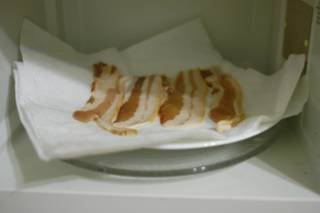
I also placed three strips of bacon on a large frying pan.
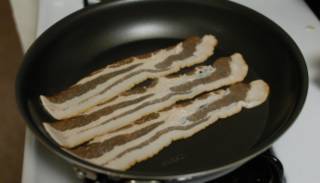
Finally, I spread out four strips on an aluminum foil lined baking sheet (for ease of clean up).
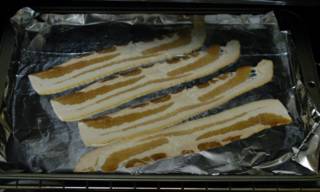
Method 1: Microwaving
I ran the microwave on high for 3 minutes. After three minutes, I checked to see if the bacon was done (should be crispy). In my case, it was. If it's not done, give it another 30 seconds and look again. Repeat until crispy. Nothing could be easier.
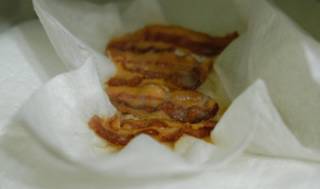
Method 2: Pan Frying
I placed the cold pan with bacon over a medium-low heat. The heat should be high enough that it cooks the bacon, but low enough that you can cook the bacon for a long time without burning it. If the bacon starts to look like it's going to burn (little bits of black start forming at the edges), turn down the heat. Cooking the bacon over low heat will render the most amount of fat out of the bacon. If the fat collects too much (1/4 in. depth), then spoon off the excess fat. Since I was only cooking three strips, there wasn't much danger of this.
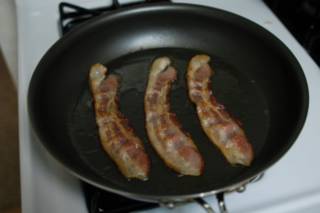
Keep turning the bacon over to evenly cok both sides. When the bacon reaches a deep brown color, it's done. Mine took about fifteen minutes.
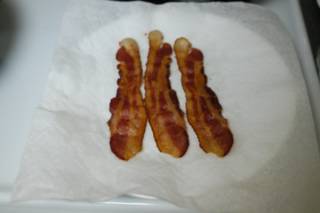
Method 3: Broiler
After placing the baking sheet directly under the broiler, I turned it on. Every couple minutes, I pulled out the rack and flipped the bacon over.
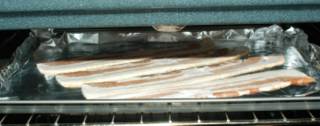
Unfortunately, it was very difficult to control the cooking of the bacon under the broiler. As the bacon curled up, the fat started to scorch and burn. After about eight minutes, I pulled it from the oven to prevent the rest of the pieces from burning.
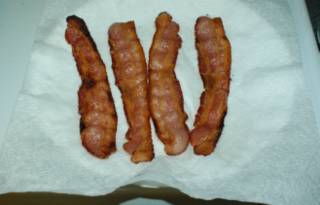
Conclusions
Microwaved - The bacon came out extremely crisp throughout both the fat and meat of the bacon. It felt a bit thicker than I expected from a thin cut piece of bacon. Examining the fat collected in the paper towels leads me to believe that very little fat was rendered out in comparison to the pan fry method. The technique is simple and hands free, but a problem that I have is that the paper towel stuck to several of the pieces of bacon. This may have been because I allowed the bacon to rest and drain on the same paper towel it was cooked on. Another issue is the limited number of bacon strips you can cook in a microwave oven at one time (but the time savings probably more than makes up for this).
Pan fried - The bacon felt the thinnest and lightest of the three. The bacon fat was crispy while the meat was slightly chewy. I actually prefer my bacon this way (not totally crunchy and crispy, but with some texture to it), but others may not. All in all, a good method to cook bacon but time consuming.
Broiled - The bacon was burnt in some spots and the meat felt undercooked. The areas need the burns were bitter in taste and the texture was soft and soggy throughout (except for the blackened parts). Not much fat was rendered off either. I would not recommend this technique.
So, microwaving is king if you're looking for bacon that feels thicker than what you purchased and crunchy throughout. Pan frying is great for a thin, light bacon with a little chew in the meat.
In the future I will test other methods of cooking bacon including baking on a rack (a favorite for many). For now I need to recover from eating nine slices of bacon in an evening.
An aside: Earlier in this article, I cooked the bacon directly on some paper towels. There might be some possible health concerns when doing this. There was once a popular internet chain mail scam/hoax claiming that microwaving Saran Wrap (or other plastic wraps) will release a chemical contaminant called dioxin into the food you are cooking. This was not true if you are using plastic or plastic wrap products labelled microwave safe (in the United States) as these do not contain any dioxins. A supporting e-mail later went on to encourage the use of paper towels instead for microwaving. As part of the backlash against this e-mail hoax, it was put forth that using paper towels might contribute more dioxins into your diet because the bleach used to produce paper towels contains chlorine and chlorine and wood form dioxins. There are plenty of websites that claim that dioxins are formed during the production of the paper towel or that microwaving creates dioxins, but I haven't found one that doesn't make a scientific error in their claim or discussion of the process. To my knowledge, dioxin is produced during combustion, which is not a part of the paper towel making process. The conclusion? I don't know. The Federal Drug Administration (FDA) just says to use products marked microwave-safe.
69 Comments:
I'm a huge fan of pan frying. But I love bacon the best after it has been cooked thoroughly, then put in the fridge after a day. Mmmmm! Cold bacon!
And 15 minutes sounds about right for pan fry. Do like Emeril says and use the adjustment knob and set it to medium. Keep your eye open for lean bacon at the market!
Instead of cooking the bacon on a paper towel in the microwave, you might want to try a tray like this one.
-ryan
http://theryanking.com
Looking at the ridged plate made me wonder...could you George Foreman grill bacon? It might end sort of oddly shaped though.
When I was a professional cook we would bake our bacon (pun unintended) in the oven at around 350 - 400 degrees I'm guessing that it took around 8-10 minutes but the bacon could come early or late depending on how you like your bacon (less time for chewy bacon more time for very crisp bacon) it's a fairly consitient way to cook bacon without having to watch it every minute.
-Nik (dakan AT flashmail DOT com)
I think in part II, I will try baking, grilling indirectly, and find someone with a George Foreman grill.
Your experiment made my hungry! I love bacon but I still don't know how to cook them properly. I don't like it crispy because I like them limp in a sandwich.
Will try your method, then maybe I will see some consistency in my bacon cooking.
Thanks for the experiments! Like Nik, I bake bacon at 400 degrees for about 10 minutes. I get mine from my local farmer's market and there is nothing better at brunch on a fall morning.
For an unparalleled breakfast-meat experience, try brushing the bacon strips with a little real maple syrup before baking.
One of the problems I've had with cooking bacon in a pan is that I like turkey bacon which often times has much less fat than regular bacon. This seems to make frying much harder since no juices are let off to cook it in.
Important question -- is the bacon thawed, or frozen, when you start microwaving it?
A popular restaurant method of cooking bacon is to deep fry it. This is quick and is great for large quantities (assuming you have a large deep fryer). The bacon comes out crisp but usually is not very straight - it ends up curled like a pig's tail.
The bacon was thawed prior to cooking in each of the methods.
Which one tastes the best?
Great experiment, got a good feel for cooking methods and textures and evenness of cooking. One Question, which one tasted the best? I have tried them all and found that i like the taste of slow fried bacon the best.
re: Which tastes the best
I felt that the flavor produced by the microwaved bacon and pan fried bacon were similar. The texture contributes to how you feel when you eat it, so for my the pan fried bacon was the best given that it was not hard and crispy all the way through.
Alton Brown suggests broiling your bacon on a cooling rack inside a cookie sheet lined with foil. This allows the fat to the foil and keep the bacon dry.
Philip
Hmmm i love bacon. I have tried only frying and micowaving it though. A good possible way would be also to grill it over a flame from either charcoal or propane. when i have the chance i would try it with coal as it always has better flavor than propane. But u gotta get the coal thats real smoky not the fabricated ones. If anyone gets a chance to try this i would like to know the results. Interesting article
I'm definitely a fan of broiling - but with a rack so the grease drips off and lets it get nice and crispy.
yum.
When pan frying bacon, my bacon always became really crumbly and came apart like it was made of sand. I finally figured out that you have to clean out the grease before every new batch. Makes yummy bacon!
Ok, so I'm not American and I suspect this is a cultural difference in naming; but what is "broiling"?
For the record, Bacon should only ever be fried, best in a little olive oil or pork fat (handy if you're planning on cooking sausages as well).
The exception to the rule is bacon joints, which should be boiled in (weak) brine.
re: Broiling
From the CfE glossary: To cook food directly under the heat source. Typically refers to placing food immediately under an oven broiler.
Most ovens (at least in America) have a broil function where the flame comes from above allowing you to place food directly under the heating element. Other ovens only have one heating element (at the bottom) and have a tray where you broil below the heating element.
Some light -
Broil = Grill depending on which part of the world you live in.
Microwave your bacon between two paper plates to overcome the paper towel problem, also one less dishe to clean.
Thanks Glen, so:
Grilling == Bar-be-queing/Char-grilling;
Broiling == Grilling;
Gotta love i18n
i'm into cooking myself and the greatest problem a(bout bacon)i've yet to solve is how to cook crispy and straight bacon strips. they usually end up curly and crumbly. will definitely try your suggestions. and any suggestions for making gravy?
I cook bacon in the microwave frequently. I use a flat bacon cooker from Nordicware that is different from the round one referenced above. This is a slanted device so the grease runs off into a depression at one end. I put paper towels (2)under the bacon and flap 2 more over the bacon. The paper absorbs almost all the grease, and the bacon comes out straight and crisp. I can get up to 6 slices on this device. Cook times vary with the cut of bacon, it's thickness and degree of wetness (which varies by brand and indeed in brands from one package to the next)and number of slices on the cooker.
I cook the bacon for 2-3 minutes on high power and then turn the cooker plate 180 degrees. After using the microwave for several years, I can gauge the time needed to finish the cooking depending on doneness at this time.
The downside to using the microwave, IMO, is that the bacon comes out almost too crisp vs. using a frying pan. Pros are the speed of cooking, ease of cleanup, and straight strips when cooked.
Cook's Illustrated has an article on cooking bacon in the oven. This is a subscription magazine, but, maybe this link will work to see the article. They use a little different approach than our host did in his test which obviates burning the bacon, but, is a bit work intensive compared to the microwave. Here is the link
http://www.cooksillustrated.com/article.asp?did=476
Bake it!
Baking bacon gives superior results to pan frying, it saves your sckin (no grease splatters), it requires less active work time for the cook, an entire package can be made on one baking sheet and it doesn't stink up the house as much.
Trust me, one package or bacon spread out on a jelly roll pan in a 350 oven is the way to go.
Bake *all of it*. I like to bake up two pounds (or more) of bacon at a time in the convection oven. Most of it goes into zip locks in the freezer. Then when I need a piece or two I just give it a quick warm up in a pan (if I want a little bacon fat) or in the microwave.
This way you only need to do the big messy clean up once in a while.
I have read that Protein 'curls' above approximately 170', and consequently I try and cook protein slowly, and attempt to avoid 'curling the protein'. I also note that most meat thermometers state 'doneness' at +/- 170'. This also seems to work cooking broths, soups, stews etc., as there is less crud (protein??) floating on top. Apparently, also, when the protein is 'cooked' the food won't stick to a non-coated pan or grill. When the food can be 'pushed (not sticking!) it is the earliest, a good time to flip or move.
George Foreman works great. Grease slides all down into a tray.. It doesn't get wavy and cooks both sides at the same time :)
I just use a Pyrex square pan (the kind you would cook Lasagna in), in the microwave. Every three minutes I drain it. You can cook 1/2 a pound of bacon this way, and it is a lot easier than frying.
re: microwaving bacon
I must have a small microwave oven... The largest pyrex container that I can fit is an 8 in. square. My bacon is 12 inches long... There's no way I can fit 1 lb. of bacon in the pyrex dish without stacking. Do you microwave them stacked?
The best bacon in my opinion is turkey bacon, and the best way to cook it (or at least the easiest) is to put about eight strips on a piece of parchment paper on a baking tray (or cookie sheet) and bake in the oven at about 350-375 F for about 10 minutes. Delicious.
I consider it borderline sinful to waste something as wonderful as pork fat, so frying a few strips of bacon is usually a prelude to frying something else in the rendered fat -- some eggs, or asparagus, or a steak. Panfrying just makes more sense when I'm going to toss something else in the pan right after I take the bacon out.
Everything but the squeal...
I am wondering about the effects of microwaving the bacon at different powers.
Is the "paper stick" factor reduced by cooking it at 50% power instead of 100%? Is there a desirable change in texture? eg: less crispy; more chewy?
If you need to cook a lot of bacon in a small microwave, you can stack it. Using the paper towel technique, just put a couple on the bottom, around 4 pieces of bacon, another paper towel, more bacon, paper towel and so on. I always throw a couple of paper towels on top of the pile to keep splatter down. You just need to increase the cook time. You can do an entire package and get crispy, straight bacon in approx 6 mins or so (depends on your microwave). The paper towels absorb all of the grease, but if you can fit some sort of plate in there, it is helpful for any run off.
I'm a bit late to the game but my prefered method is to use a sandwich press (2 flat hot plates, pressing the bacon in between) this lets you cook to the desired level of crispyness (or not in my case, I like lean non crispy bacon) and keep it falt. cooks really quickly too.
RE: Cooking bacon in the microwave.
We use the trick of using two plates together: 1 dinner plate, and a smaller side plate.
Upturn the side plate in the middle of the dinner plate, and drape the bacon on the bottom of the side plate (which is now facing up).
The bacon cooks; the grease drains down the sideplate and is caught by the dinner plate.
We also use a piece of kitchen roll over the top (so it doesn't spit everywhere) and voila!
PS: It's an idea to intermittently open the microwave and unstick the kitchen roll from the bacon.
please no cup measures - why not weigh (in g/kg).
temps in C not F please.
re: measuring cups
Unfortunately, here in the United States, most recipes are written using volumetric units for solids. I have been endeavring to provide the correct mass units as well in more recent articles, but haven't had the time to go back to fix the older articles.
I was wondering if on the next iteration you could try pan frying using a cast iron pan. My sister insists that this is the only way to cook bacon (for evenness, etc.) and I'd love to see a comparison.
Great site! I love to cook, and I love the layout of your recipes ... they make perfect sense!
Bacon, difficult topic.
The americans like crispy, streaked bacon.
Brits like bacon back and cooked not burnt.
Interesting article, but for me and most of the people i know, well we cook it in the pan or the grill (americans: broil). the biggest difference once the meat is cooked and the fat has coloured then it is ready. teh use of back bacon means that there is more meat less fat.
also crispy back bacon is not very edible.
Best of both worlds - bake your bacon on the broiler pan!
The grease drains down below - where it can be collected for frying up stuff like home-fries - and the bacon lays straight and gets cooked. I like mine particularly crisp, so I let it cook for about 20 minutes at 350.
I have a smaller microwave, too - and my experience is that messing with paper towels and whatnot is a pain. Baking is just as fast as "slow frying," but without all the popping and splattering!
I have found a new way to make bacon, the "makin bacon" dish. I dont like to cook but love doing this.
All of the fat drips off durring cooking, an amazin amount of fat actually.
http://www.makinbacon.com/cooking_with_the_dish.htm
Curling of bacon strip while frying/broiling can be minimized by making a series of little cuts along the meaty edge of the bacon. M.E. in DSM, IA
Do not cook bacon at any temperature above 300 degrees. The sodium nitrate used to cure and preserve bacon converts at high temperature into (potentially) cancer causing compounds. This is information was put out by the FDA in the 70s (and in many current cookbooks) and you can confirm it yourself. Take some pieces of bacon from the same package, so it should taste exactly the same, and fry some fast and hot in a frying pan. The remainder put in the oven on bake at about 250. It will take approximately 6 hr to crisp bacon in the oven this way. The pan fried bacon will have a bitter taste where the oven baked will taste much better. The drawback is the cooking time. On weekends I put my bacon in our electric oven set as low as it will go and leave it on overnight. I also use a pan with a rack to drain the grease away. Sodium nitrate is also used to cure hams, sausage, and jerky but has not been shown to produce the same cancer related compounds in those products no matter at what temperature they were cooked. A great referance still in print is "Great Sausage Recipes and Meat Curing" by Rytek Kutas
As an alternative, buy uncured and/or perhaps organic bacon at a natural food store if you can. It may cost more now, but compare to the price of your health and health cost later. Plus, no worries over antibiotics or meat fed other animal parts with mad cow yuk-yuk.
I've been using one of those special microwave trays that the second poster linked to. It works OK, but it is hard to time it right to get crisp bacon. I used to use the paper towel method but it gets frustrating because my wife buys whatever brand is on sale and some brands of paper towel and bacon stick together like crazy.
So now I am back to the pan fry method of my pre-microwave days. This was taking me 15 minutes, too, in a cast iron skillet, but I figured out if you are only doing three or four strips, use a 9 inch teflon pan. Yes, it is too small for the bacon when you start out. You have to scrunch it in there a little. But, soon, the bacon shrinks to fit, out comes the fat and now you are "deep" fat frying. I can do four strips in about six to eight minutes. You did not mention to drain the bacon on paper towels to crisp it (it only takes 30 seconds longer), but I think this is key also. I like this bacon better than any microwave. And the teflon pan is easier to clean than the microwave tray.
For weekend breakfasts, I melt bacon. Using an AllClad double-burner griddle, I cook eight to ten strips of bacon over very low heat - 1½ on a scale of 9 - for 90 to 120 minutes. The strips cook nearly flat, and turn a mahogany color unique to this process.
As to keeping the bacon flat.
My Dad alway used what he called a "bacon press", he made it out of a peice of stainless steal about 4"x8" and welded a handle to it. While the range was heating he would let the press sit on the range also, heating with it. Then when he placed the bacon on the range he would put the press on top of it, the bacon couldnt curl up because of the weight of the press.
tada, flat bacon :-)
Thanks for the kitchen science!
I found a recipe this weekend for Amish peppered bacon.. it sounds bizarre, but also fabulous.. dip the bacon in egg, then coat it in a light coat of peppered flour, THEN fry. Doesn't end up with a thick coating, but is crisp and strange and different!
My arteries don't feel quite strong enough to try it yet...anybody feeling invincible? Let us know how it tastes!!
Roasting (baking) it keeps it flat. This is really the best way to go because when you pan fry it the ends curl up and dont cook through (yuck). I always buy thick cut bacon that's not commercial, so it doesn't have much sugar. I roast it at 425 degrees for 15-17 minutes, depending on the thickness of the bacon. If you're using bacon with lots of sugar, it might burn at 425.
I believe it was a comedian that said this although I do like the slow cook pan fry method. Most people like to rush it. The quote was something like "The only way to cook good bacon is in the nude". The idea being that if you cooked it at a low enough tempurature it wouldn't splatter and the fact that you were nude would ensure you didn't get impatient and raise the heat. All said and done, microwave works great and is quick. Also, if you bake your bacon (350 unitl sone on a cookie sheet) which I did for years in restaurants and then let cool and put in a freezer bag you can cook a months worth in one setting. Heat in the microwave for 20-30 seconds and its good enough for family table. you might want to just under cook it because when you reheat it will cook some more. It's not crispy
this way but fuctional
My two cents on this subject.
Clean brown paper bags can be used instead of paper towels.
If you add clean up time, the microwave wins hands down. Toss the paper towels and you're DONE.
I like my bacon backed. It seens not to shrink as much. I would like if it you would put it to the test.
Duane
LDA007@hotmail.com
Cook it on low heat and it will not burn, curl or have a weird texture. My mama taught me how....you have to be Southern to cook bacon right!
i'm another "bakin' bacon" fan. i've tried it all ways like you did and baking is now my favorite method -- it's slower, but unless i leave my oven for too long i always get perfect results.
Yum, bacon. :) Try microwaving at 33% power for 3x the duration. I think microwave energy behaves much more like a conventional heat source when "derated" this way. I'd be interested in seeing how much more fat slow microwave-ing renders (if any.)
My favorite it grilling bacon. Especially if you're using a thicker cut. I prefer maple smoked country cut. Unfortunately, it is almost too cumbersome to start a real fire just for bacon, but a medium heat gas grill works fine . . . just keep an eye on the flame ups.
I cook my bacon in a contact grill, similr to the George Forman EXCEPT I have temperature control and flat OR ridged plates. I use the flat & usually turn the bacon once because its so thin it doesn't contact both sides. I set the temperature anywhere between 350 & 400. Slight variations in the temperature make a big difference. The bacon comes out crispy but not crunchy. The fat & meat are equally edible (I hate overcooked meat)
I LOVE contact grilling my bacon & it's so much less messy & so much easier.
My wife, a reformed vegetarian, figured out the best way to cook bacon at home. Lay it out in a big frying pan and put an upside-down plate on top of it. Drain the grease off once or twice while cooking. Takes 15 or 20 minutes. The advantage of this method is that the bacon cooks a little faster but it doesn't get burnt and it tastes excellent.
I HAVE A BIG FAMILY THAT I COOK FOR AND USE THE OVEN . I PUT THE BACON IN A CAKE PAN AT ABOUT 350 FOR 8 OR 10 MINUTE. IT'S GREAT.
For this bacon thread, Call me Porky. I've tried all methods, even carbon steel wok-frying at 40,000 BTU's. But for 10 years I've been most pleased with BAKING.
Baking has several advantages: Flatness; full rendering of fat; an even and rich browning; collectible fat with few particulates.
Method: 1) Use broiler pan with slotted top, or rack on baking sheet. (Slotted top is easier to clean).
2) To facilitate peeling of strips, microwave the 1 lb chunk: 3 pulses of 20 seconds, rotated.
3) A light spray of Pam or a swab with lecithin on pan helps prevent those curious bacon proteins from sticking.
3) Lay pieces on pan, overlapping 1 cm., as they will shrink. Center a "column" of ca. 10 strips down middle on X axis, then use 2 side areas for 2 strips each side on Y axis. This uses ca. 13 oz, leaving 4-6 strips for other uses. Trying to crowd the whole 16 oz in causes conjoined strips that are difficult to separate.
4) Oven should start at 350F, but turned down to 225-250 after 5 minutes (Standard anti-microbial technique). At 250 it will take about 40 minutes; 225 takes 60 minutes, etc. THE LOWER, THE BETTER for slow complete rendering. Going to 150 would be safe, if initial 350 "killzone" is observed.
5) Turning: In a NON-Convection oven there are two temp zones to observe: 1) the standard "hot spots" unique to each oven, and 2) the cooler center of mass vs the hotter perimeter of the pan. Thus, turning AND re-positioning (move from center cool to edge hot, and vice-versa) yields most even results. Use tongs and a teasing fork. Ideally, each piece gets 3 turns and rotations. Remember, the factory slicer is somewhat erratic, so each piece is unique in thickness. Check every 10-12 minutes if at 250. This is all not nearly as labor-intensive as it might sound.
6) Drain on a flat paper bag with single paper towel.
The local grocery store has a twice-yearly sale featuring 7-to-10-lb packages of thick-sliced deli bacon. We fire up the smoker and smoke anywhere from 10-20 pounds of the bacon (obviously, we do it in cycles, so this is a time investment of a few hours). Once it's smoked but only about half-cooked, we take it off the smoking racks and finish it by baking it in the oven on cooling racks placed on baking sheets (with lipped edges, of course), on fairly low heat, for another 5-10 minutes. Then we store it in airtight bags and plasticware in the freezer. Whenever we want bacon, we just pull out however many strips we need, microwave for 10-15 seconds, and that's it. If we invest a few hours of one day in the smoking-baking process, we get enough bacon to last months (even when some family members go on low-carb diets and start practically living on bacon *G*).
I have the best method. Get ready made bacon like this kind.
Pop it in the microwave for a minute, and you have perfect bacon when you hear that microwave go "ding!"
I used to be a skeptic of buying ready made bacon, but after trying this out, I wouldn't go back to cooking bacon. It seems to me that the people who make this product have more concerns about perfectly cooking the bacon, and they have executed accordingly.
The bacon tastes great. It is cooked throughout, and no matter how thin it is, it still has that crisp and chewiness that makes it the ideal bacon.
The only problem I have with is the greasiness. I think they flash freeze the bacon once they cook it, so the fat is kept. My husband gave me the perfect solution:
Place the bacon on top of rice when you pop it in the microwave. The fat runs down the rice and you'll have tasty rice and not-so-greasy bacon.
I guess this would be the solution if you like bacon on rice like we do. YUM. If not, then I'm sure the paper towel trick will do after letting it rest for a bit.
It's probably more pricey than raw bacon, but hey, if you're going to live it up by eating bacon, go all the way and get ready made bacon!
Microwaving, broiling, baking and ready-made bacon may be easier/quicker/cleaner, but none can beat the flavor of bacon fried in its own grease!
Neighborcat Says:
For perfectly flat bacon, I recommend using a clothes iron set on "linen" or whatever the highest setting is.
Place the bacon on parchment paper or yesterday's Times and have at it usng firm pressure to render the fat. Be sure the water reservoir on steam irons is empty, otherwise you will have difficulty reaching the proper temperature.
I will say that if you are at all meticulous about your appearance, (as you may be if you require ultra-flat bacon) you should probably use a separate iron from the one you use on your clothes. This technique is also handy for those late night BLTs after the bar closes when staying in a hotel, as most hotels supply an iron these days, but not a microwave or stove! I have not yet found a means of using a coffee-maker for cooking bacon. The hot plate just doesn't get hot enough.
I use a microwave disch made for bacon. I believe the second poster has a link. I cook the bacon about 3/4 of the way and then transfer to a pan to finish. This has some nice effects: 1 - the bacon keeps its shape. 2 - the pan doesn't fill with the grease becuase its in the microwave dish. 3 - The microwave dish is easy to clean since the bacon was browned.
Mistake in my post above - the 3rd item should have read:
3 - The microwave dish is easy to clean since the bacon wasn't browned.
Perfect bacon?
Try Hormel Black Label pre-cooked.
Eat it cold or warm a few strips in the microwave for 30 seconds.
Mmmmmmm.
We mostly buy frozen bacon from the meat packing plant here in Ohio. This butchered bacon never, ever curls up. Thick, thin or medium sliced, it is straight. We love it. I cook bacon on a really high temp on the ceramic stove top in a huge pan. My bacon cooks up in less than 5 minutes.
Yum!
The problem we have is...the bacon tastes different. We can got a side of hog and the first bacon was scrumptious. Months later we bought a bundle pack of beef, chicken and hog. The bacon tastes weird and smells weird while cooking. Not spoiled.
Different.
What is up with that?
Someone posted about brown paper bags. In the 50's & 60's the trend was brown paper bags for turkeys.
Now a days the paper has too many chemicals in it. So please do not cook in said bags..unless you like chemicals.
Post a Comment
<< Home